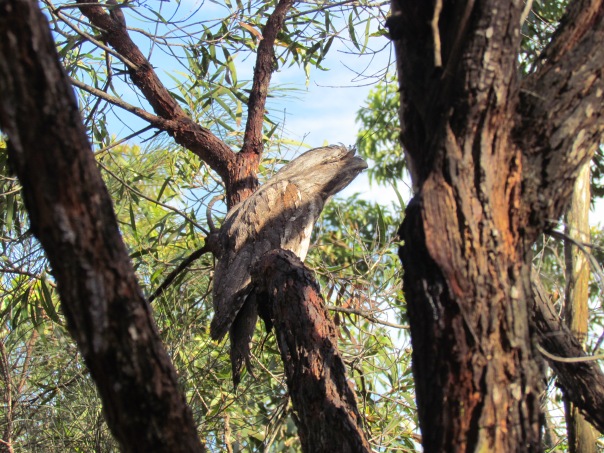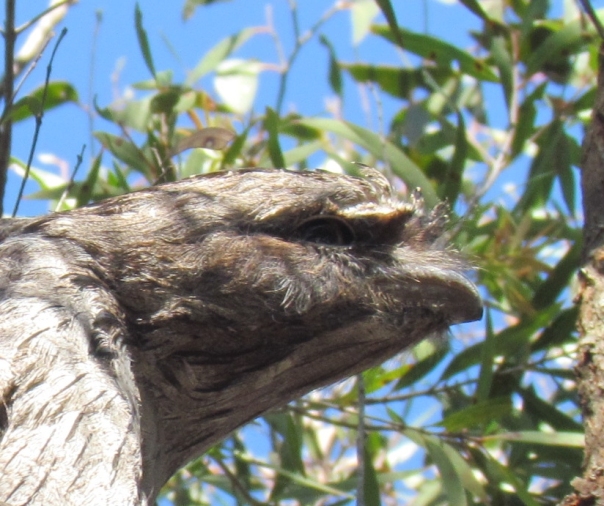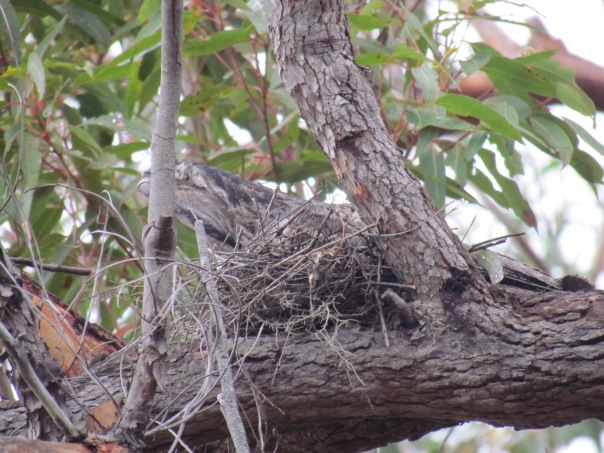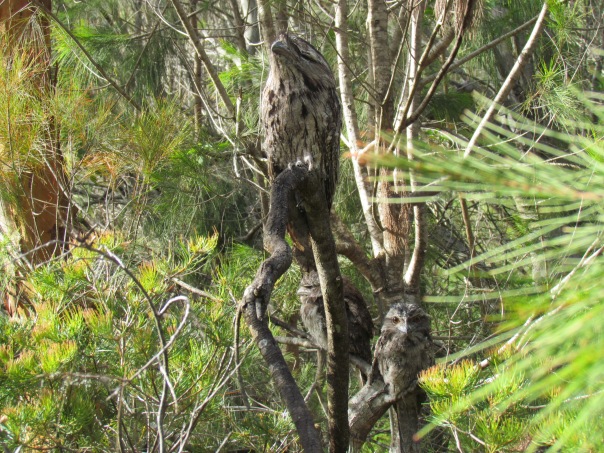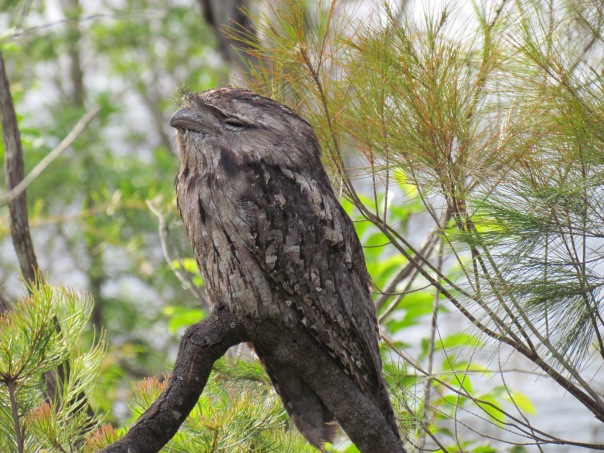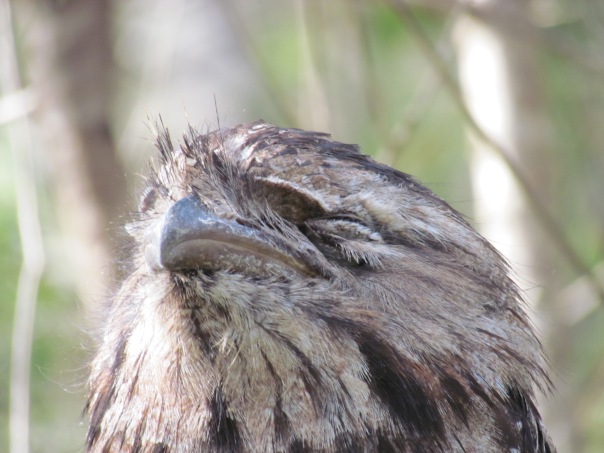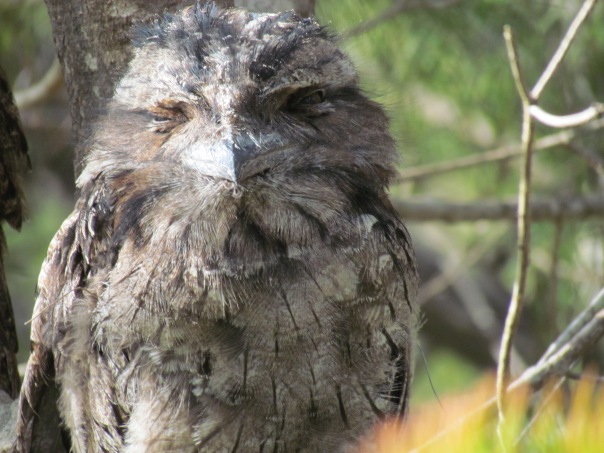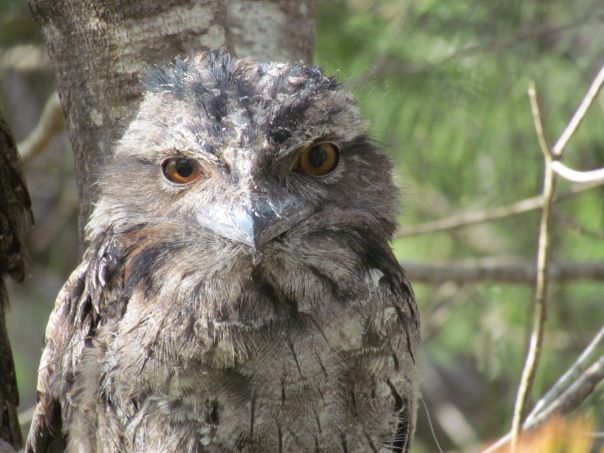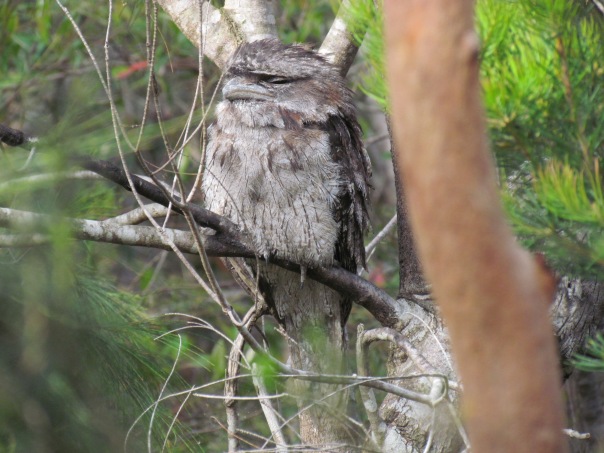Category Archives: Frogmouth
Three Tawny Frogmouths gazing at me
Tawny Frogmouths are some of the cutest birds around. They’re fluffy and cuddly, with an endearing tuft of feathers just above their beaks, and large eyes that glow brown and orange in the early light. I was strolling along a bush path when I noticed a group of three:
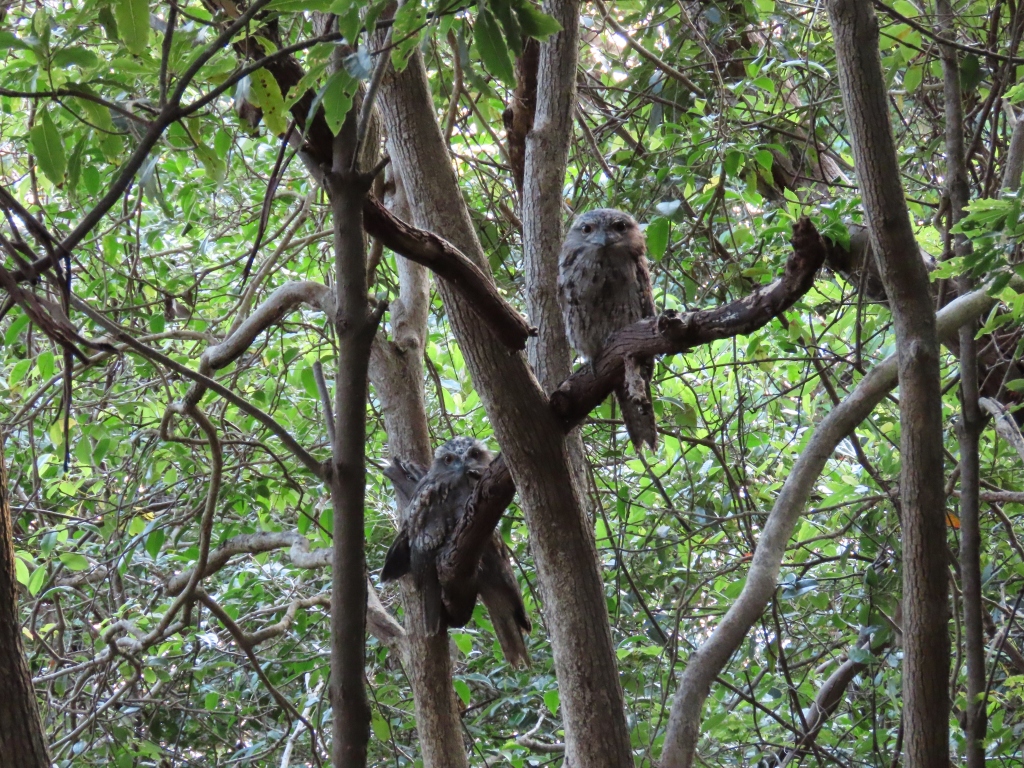
If you don’t spot the third bird immediately, that’s by design. Two of the birds are looking directly at me. The third is pretending to be part of the tree, with just one partly-open eye squinting at me. The bird is the furthest away of the three, and is partly hidden by the bird in the middle.
A closer view shows one bird hiding behind the other and trying to look like a broken tree branch:
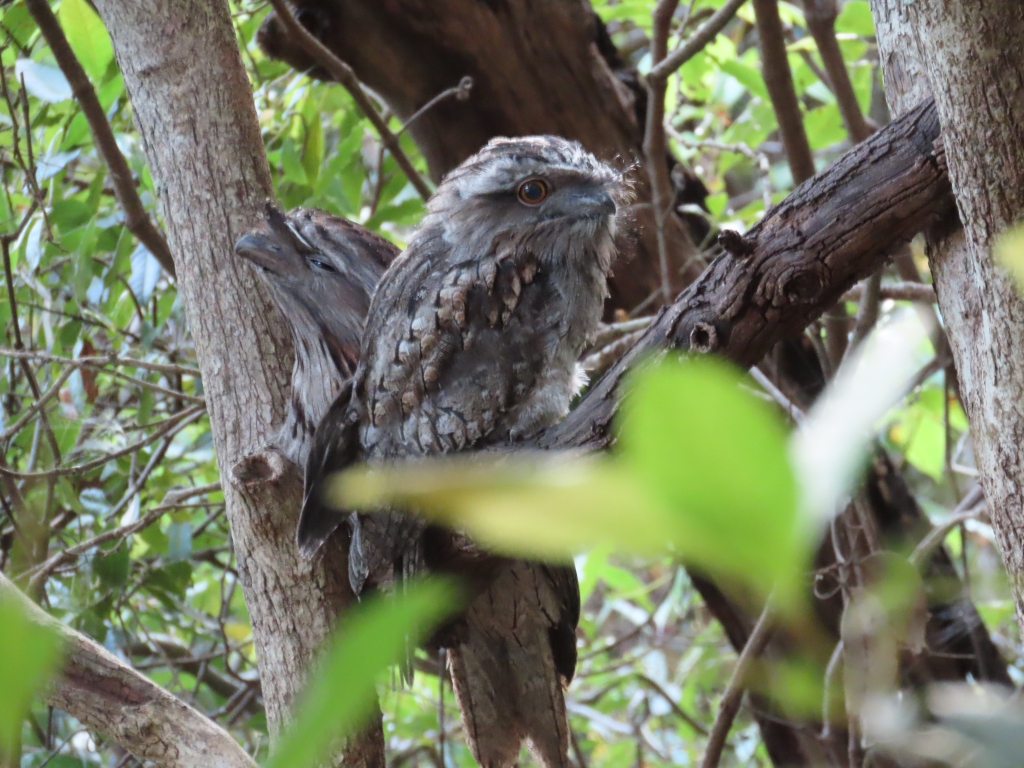
When I first came along, the closest bird had a similar stance:

It takes a practiced eye to spot a Tawny Frogmouth. They’re nocturnal, and tend to stay very still during the daytime. And their camouflage is impressive. I was excited and awed to see three of them at once.
Although they look like owls, Tawny Frogmouths are actually members of the nightjar family. Like owls, they hunt at night, preying on large insects, spiders, frogs, and small animals. Unlike owls, they don’t catch their prey with their feet. To catch insects, they sometimes fly with their beaks open. Hence the very wide beak! One theory about the tuft of feathers above the beak is that it protects the eyes when the bird is hunting.
Here’s another view of the two Tawny Frogmouths that were huddled together:
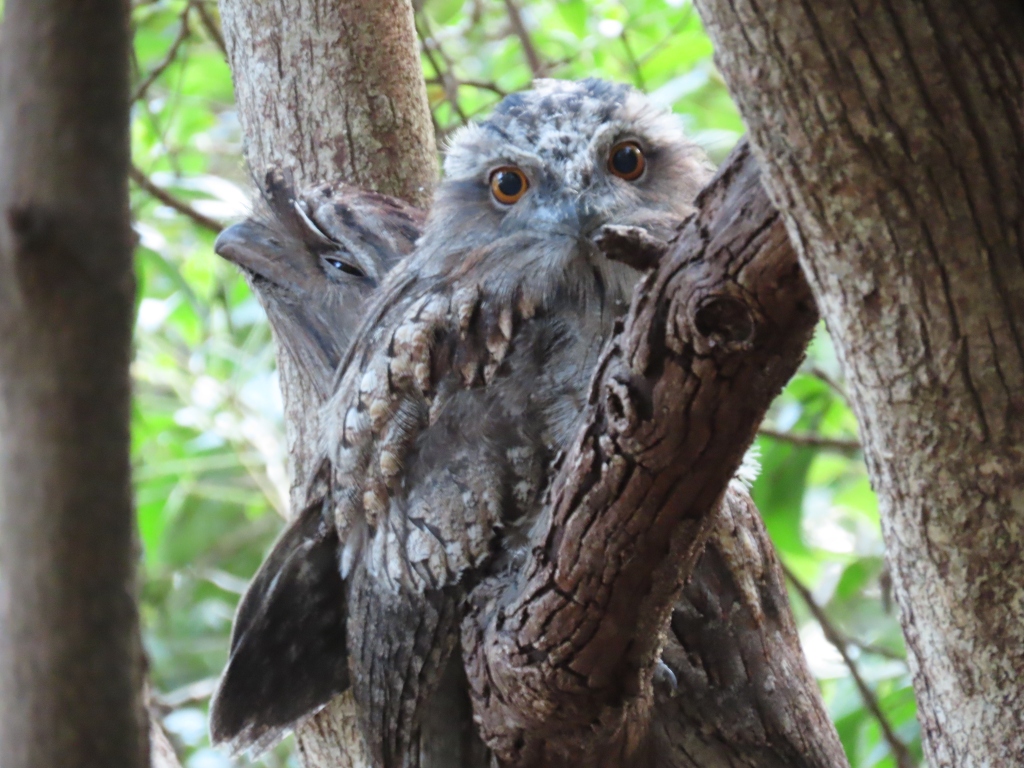
Common name: Tawny Frogmouth
Scientific name: Podargus strigoides
Approximate length: 34-52 cm
Date spotted: 5 December 2022 (summer)
Location: Reef Beach Track, Balgowlah Heights, New South Wales, Australia: 33°48’23.1″S 151°16’21.2″E
Cuddly Tawny Frogmouths
Tawny Frogmouths have to be the cuddliest birds in the world! Today I came across these two huddled up together in the winter cold:
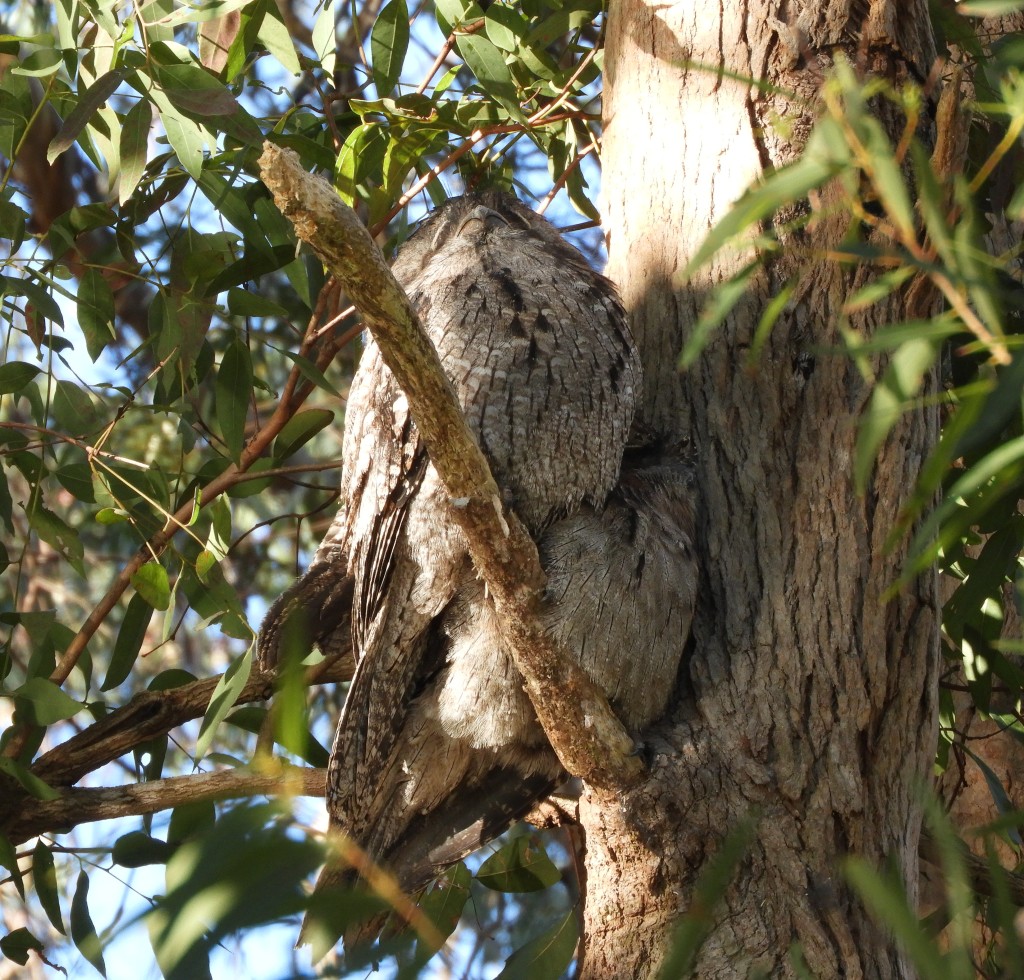
Do you find it difficult to distinguish the birds from each other and from the bark on the tree? That’s by design! Their camouflage is extraordinary. In fact, it took me ages to spot these birds. A bush walker had told me where they were, and even so it took me three trips to the park on three separate days, a second encounter with the same bush walker, and many minutes of looking before I found them.
Here’s a closer view of the Tawny Frogmouth at the top of the two-bird pile:

See the two large eyes and the upside-down smile of the beak? Tawny Frogmouths eat insects and spiders, and other small prey, which they catch in their beaks.
Around the beaks they have some rather endearing tufts of hair. People aren’t quite sure what the purpose is of the tufts. Some people think that the tufts help the birds detect insects and other prey flying around them. Other people think that the tufts keep potentially-harmful prey, like a centipede, away from the bird’s eyes and mouth until the bird has crushed it in its beak. No matter, I think the tufts make the bird look a little goofy:

Tawny Frogmouths are nightjars, though people often mistake them for owls. They’re nocturnal. During the day, they huddle together pretending to be parts of a tree.
Here’s a close view of the bird that’s lower down in the two-bird pile. In the middle, near the top of the picture, you can see one eye and the beak, and half of the bird’s body. On the left is the other bird’s body, on the right is the tree:
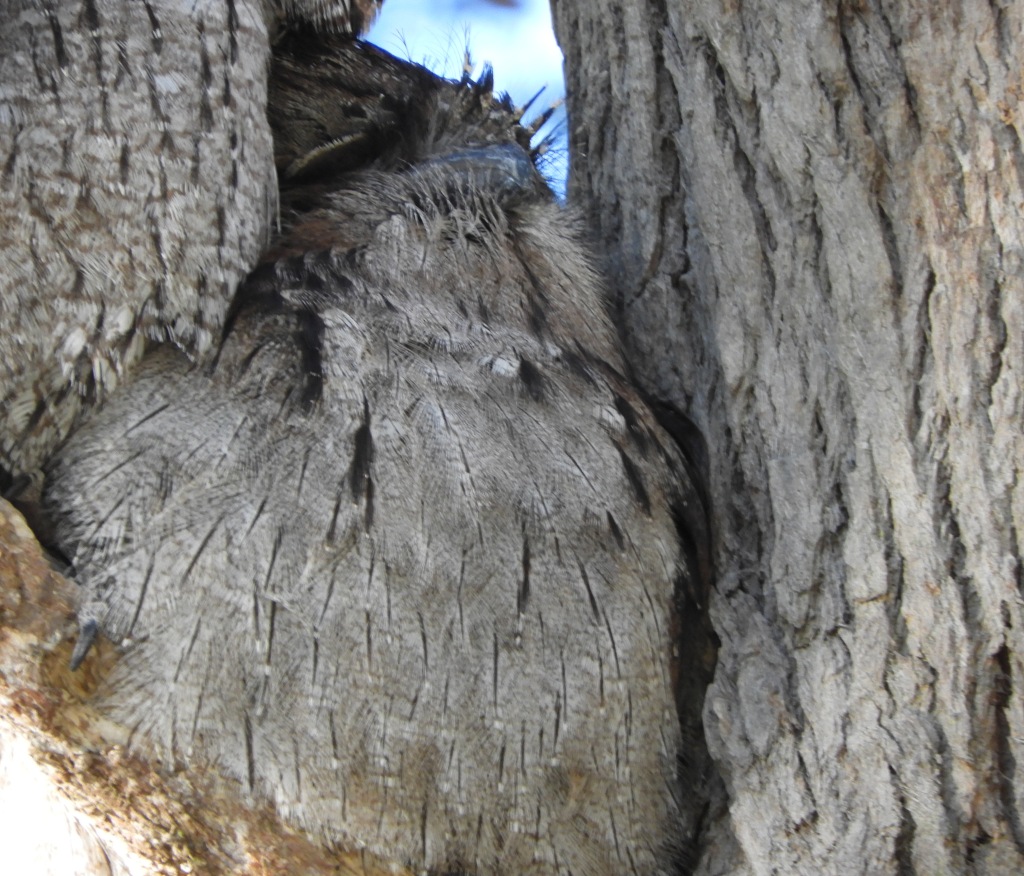
What a face!
Here’s a zoomed-out view of the birds in the tree. Spot them if you can!

To finish, here’s another angle on the top bird:

Common name: Tawny Frogmouth
Scientific name: Podargus strigoides
Approximate length: 34-52 cm
Date spotted: 27 June 2021 (winter)
Location: Manly Dam Park, New South Wales, Australia: 33°46’58.3″S 151°15’19.0″E
Update on 3 July: Here’s another photo of the birds on another day. They’d posed at a slightly different angle, which made it easier to capture a profile and a good view of the feather markings on one of them.

Tawny Frogmouth eyeing me carefully
Tawny Frogmouths are irresistibly picturesque. They’re nocturnal birds, members of the nightjar family, so they’re a bit dozy by day. This one was very aware of me as I moved quietly around below it.
Click the image to open in a new tab, and zoom in to take look at its plumage. The bird’s eye is almost entirely closed in this image.
Here’s a close up view of the bird’s head. It’s eye is now half open, keep a watch on me:
There’s not much happening in the videos, but you can see the careful, slow movements that the bird makes, trying to preserve its disguise as a dry branch:
There’s even less happening in the next video, but it gives a nice view of the bird itself. The harsh chirring noise is the cicadas, which dominate the bush at this time of year.
Common name: Tawny Frogmouth
Scientific name: Podargus strigoides
Approximate length: 40 cm
Date spotted: 26 December 2014
Season: Summer
Location: Manly Dam Reserve, New South Wales, Australia
Latitude/longitude: 33°46’26.7″S 151°15’08.7″E
Tawny Frogmouth nesting
Strolling along a path in the bush today, I spotted a strange-looking lump high in a tree. I got out my trusty Canon with its high-powered zoom and snapped a few shots. When I got home, I loaded the photos onto my PC to have a look. Lo and behold, it’s a Tawny Frogmouth on a nest.
This pic zooms in closer, from a slightly different angle. A branch obscures part of the bird’s face, and you can see its short, mouth-like beak on one side of the branch:
Common name: Tawny Frogmouth
Scientific name: Podargus strigoides
Approximate length: 34-52 cm
Date spotted: 21 September 2014
Season: Spring
Location: Manly Dam Reserve, New South Wales, Australia
Latitude/longitude: 33°46’58.4″S 151°15’07.2″E
For more shots of these intriguing birds, check out the Frogmouth category of this blog.
Tawny Frogmouths chilling out
I had a real treat today: I spotted three Tawny Frogmouths, and they were in a reasonable accessible place for photography.
Tawny Frogmouths are odd, appealing birds. They’re related to nightjars, and look a bit like owls. What makes them special is their very wide beaks. When a Tawny Frogmouth opens his mouth, it looks as if his head has split in half!
Being night birds, they sleep during the day. Their camouflage is amazing. With their grey dappled, striped feathers, they look just like bits of old wood. They take advantage of this fact by arranging themselves artistically on old tree trunks. Spot the three birds in this photo:
Common name: Tawny Frogmouth
Scientific name: Podargus strigoides
Approximate length: 34-52 cm
Date spotted: 15 December 2013
Season: Summer
Location: Manly Dam Reserve, New South Wales, Australia
Latitude/longitude: -33.778347,151.249715
Bird number 1 is the star of the show, chilling out at the front of the trio. Here are some close-ups:
I love the stylish tufts above the beak!
From another angle:
Bird number 2 is on the right in the back row of the trio. I think this one was the designated sentry. Half awake:
Photographer spotted, both eyes wide open:
This is bird number 3, on the left in the back row of the trio, all fluffed up and cute. Perhaps a juvenile:


